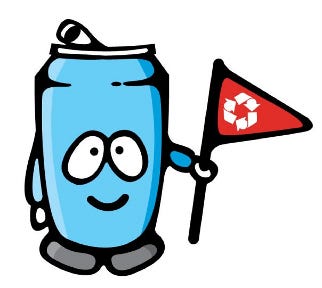Aluminum can recycling rate reaches highest level in more than a decade
January 30, 2014

Aluminum can recycling raises $150,000-plus for charity
The U.S. recycling rate for aluminum beverage cans has reached its highest level in a decade, with 58.1 percent of all cans recycled last year—a rate that is more than double that of any other beverage container, the Aluminum Association, Can Manufacturers Institute (CMI) and Institute of Scrap Recycling Industries (ISRI) have announced.
Nearly 56 billion aluminum cans were recycled in 2010, leading to a used beverage container (UBC) recycling rate of 58.1 percent—the highest in 11 years. Because it takes 95 percent less energy to produce a can from recycled material, the high recycling rate also resulted in significant energy savings. The amount of energy saved just from recycling cans in 2010 is equal to the energy equivalent of 17 million barrels of crude oil, or nearly two days of all U.S. oil imports.
"We are pleased the recycling rate has increased from last year—this is a boost for our industry and further evidence that the aluminum beverage can is the best environmental and sustainability packaging option," says Steve Larkin, president, The Aluminum Association. "Of course we must do more at the federal, state and local levels to enact recycling policies and awareness, and this is a task we continue to pursue aggressively. We continue to look for partners who are also sincere about making a real change in how we approach recycling in the U.S. today."
Aluminum beverage cans are unique in that they can be infinitely recycled back into new cans, keeping waste out of landfills and providing a significant amount of the material to make new cans. Indeed aluminum cans not only have the highest recycling rate of all beverage packages, they also have the greatest amount of recycled content—by far—at 68 percent.
"There's a huge difference between what's recyclable and what's actually recycled," says CMI president Robert Budway. "Not only are cans infinitely recyclable back into new cans, they actually are being recycled at a rate nearly twice that of every other beverage package. This, coupled with the fact that aluminum cans have the highest recycled content and provide the longest shelf life of any beverage package, underscores why the can truly is the sustainable solution for twenty-first century packaging."
"As the first link in the manufacturing supply chain, the scrap recycling industry provides vital feedstock material sought after by industrial customers around the world, including more than 4.6 million metric tons of aluminum scrap processed in the United States and shipped throughout the United States and more than 50 countries in 2010," says Robin Wiener, president of the Institute of Scrap Recycling Industries. "Aluminum cans represent a valuable portion of these recyclable commodities. Recycling is much, much bigger than the bin at the curb. Our industry provided a $77 billion boost to the U.S. economy in 2010, protected our environment and helped save energy and natural resources."
The aluminum beverage can is, by far, the most valuable package in the recycling stream and is the only packaging material that covers the cost of its own collection and re-processing.
In 2008, the Aluminum Association adopted a goal of recycling 75 percent of aluminum cans by 2015. The recycling rate at that time was 54.2 percent, and it has been gradually climbing upward since then; the 2009 UBC recycling rate was 57.4 percent.
Source: The Aluminum Association
.
About the Author(s)
You May Also Like


